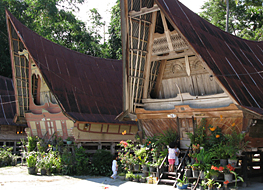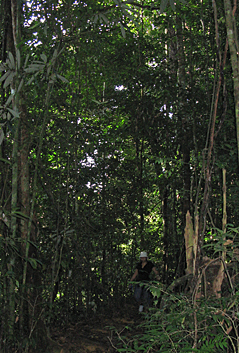North Sumatra •
Central/East Java •
South Sulawesi •
Flores/Komodo •
Lombok •
Bali •
Maps & Itinerary •
Facts •
Still Life
Gallery
P
Arrival in Sumatra
Early morning in Medan, the largest city in Sumatra. Originally founded in
the late 15-hundreds the area saw no significant development before the
Dutch started to invest heavily in the 1860s as with so many other places
in this part of the world – for better or worse. And like most cities its
inhabitants are a mix of Muslims, Chinese, Christians and Hindus with a city
centre dominated by China men, well known for their hard working business
skills and their ability to get a shop going. Foreigners come here for
mainly two reasons: Orang-utans or business.
From Medan we went on a four hour drive through immense oil palm plantations
and stunningly beautiful scenery to get to Parapat, famous mountain and lake
resort on the east shore of the volcanic lake of Tao Toba. This is the land
of the Toba Batak people. Learn the word Horas and you know hallo, goodbye,
hi, good morning, congratulations, etc. Very useful.
Parapat as a resort was developed by the Dutch (again!) as a weekend getaway
from the tropical heat, humidity and insects of the lowlands. The real gem,
however, is the sheer natural beauty, Samosir Island and its people in the
middle of the lake.

The legend of Lake Toba
Tao Toba lies at 900 m above sea level and was created some 75,000 years ago
by one of the most violent volcanic super-eruptions ever. The official legend,
however, tells a very long story about the daughter of a god who turned into
a fish and against the will of her father married a rice peasant. Her father
in return sent a seven day thunderstorm that filled the lake with water. Why
she turned into a fish before she had a lake to swim in (or why the farmer
wanted to marry a fish) the story doesn't account for – anyway, this seemed
to us the least complicated legend on the origins of the lake. Several
hotels and restaurants have paintings of Noah's Arc on their walls as the
Bataks now adhere to the Christian faith – mixed with their own original
heritage, of course.
By the way, the Bataks do not advertise their ”peculiarities” too openly. If
you pass a restaurant with the lettering B1 on the door, you may enjoy dog
on the menu – B2 means pork.
The Buffalo Stance
Samosir Island – or Island of the Dead – is the result of a later volcanic
explosion in the middle of the lake. Here you'll find lots of small villages,
museums and sites connected with local folklore and legends.
In the village of Simanindo we watched the traditional folk dances of the
Batak people. As always dances and festivities are about the cycle of life
with references to fertility and to the buffalo as the most prized of all
domesticated animals. At Huta Bolon we got a closer look at the traditional
Batak houses, their interior and their intricate carvings. The original
Batak houses are not really built any more. The construction is very
expensive, and it takes about two years to complete a single house. Not
because it's exceedingly difficult but you have to ask the medicine man on
which date to chop down trees, when to start digging, when to move in, etc.

Everybody regardless of heritage and religion consults their medicine man
about everything – just to be on the safe side. This also makes it a bit
difficult to take pictures of people as these may, of course, be used for
black magic. Remember to ask first.
Head-hunters of the Past
The gruesome past of these people as head hunters and cannibals is still
evident today. Ambarita is one of the villages with an old execution site.
Here prisoners were tortured by being cut open with knives and their wounds
rubbed with lime. Sometimes the chief would cut out a nice chunk of raw
flesh to eat and allowed others to follow suit. And then finally, mercifully,
the prisoner's head was chopped off. Only to be shrunk, of course.
Highland Ginger Tea
From Prapat to Brastagi we took to the narrow ring road of Tao Toba. First
through dense jungle-like growth but as we ascended fields of corn and
coffee appeared. Right in the middle of no-where we encountered the now
abandoned headquarters of the Forest Department – shaped like a fish. You
figure it out.
At 1,500 m asl we had a good strong cup of ginger
tea served with fried bananas at the locally famous Simarjarunjung
restaurant. Other highlights were the ancient King’s Palace of Simalungun
at Pematang Purba (housed 13 generations of rulers until 1924), and the
slender 120 m high Sipiso-piso waterfall.

Flash Flood
We arrived at the village of Bukit Lawang in the afternoon, and both
temperature and humidity had gone through the roof. In 2003 Bukit Lawang
was hit by a flash flood that killed more than 200 people and almost swept
the entire village away. Since the flood many of the village's children
had taken it upon themselves to feed their families and they were all very
eager to either sell us something or take us jungle-trekking.
We spent some time by the Bohorok River dipping our toes in the cool water.
In the evening a hefty thunder storm passed with lightning that brought
daylight to the jungle canopy and so much rain that gutters and such sent
water in all directions.
Calling the Human of the Forest
Early next morning we left the lodge with our own ranger Anto, a cheerful
little man who told stories about every plant and tree that we passed on our
way. First we crossed the Bohorok River and after an hour's walk we
entered the Gunung Leuser National Park proper. This is primary jungle that stretches
almost to the northernmost tip of the Aceh province. Here it's still
possible to find the indigenous animals of Sumatra like the tiger, the
elephant and the rhino, however, in dwindling numbers. We had chosen not
to go to the orang-utan feeding station in the park but to venture out
into the jungle in the hope of seeing some real live wild ones. This also
meant that success wasn't guaranteed.

Once in the park Anto started to make noises – orang-utan calls – and we
didn't wait long before we heard a reply. Chasing the sound we went along
barely visible paths but were able to make headway. Then we spotted one.
High in a tree. Various calls made it come closer and when Anto offered
ramputan fruits it surrendered. It was a beautiful female orang-utan with
a baby. It came up to us and took a fruit from Anto's hand while carefully
scouting the surroundings. Lene also fed her but she wasn't always quick
enough so the female jerked Lene's hat to speed things up.
Close Encounter
Anto kept on calling and soon another female appeared. We also fed her
some ramputans, and finally we got a small female with an even cuter baby
than the first one. They stayed with us for quite some time and gave us a
first rate opportunity to study this human of the forest at close quarters.
Real magic.
Food for vegetarians is not easy to find in the rain forest and
orang-utans usually cover large areas everyday in search of something to
eat. By giving them just of couple of fruits everyday the orang-utans feel
that it's worth their while to stick around in the reservation. And this
protects them in many more ways.
The cool and fresh air of early morning had now turned into a
sweat-dripping experience. We fought our way back to the lodge through
wilder-ness and paths that barely existed. At least that's how we felt. No
doubt Anto knew exactly where we were and by leading us through a couple
of bushes he gave us a feeling of real exploration and adventure. But we
loved it.
